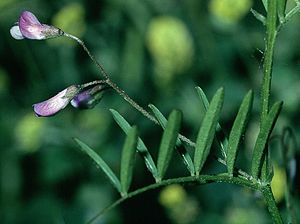Four-seeded vetch
| Four-seeded vetch | ||||||||||||
|---|---|---|---|---|---|---|---|---|---|---|---|---|

Four-seeded vetch ( Vicia tetrasperma ) |
||||||||||||
| Systematics | ||||||||||||
|
||||||||||||
| Scientific name | ||||||||||||
| Vicia tetrasperma | ||||||||||||
| ( L. ) Schreb. |
The Vicia tetrasperma ( Vicia tetrasperma ) is a plant of the genus Vicia in the sub-family of papilionaceous (Faboideae) within the family of the Leguminosae (Fabaceae). It is originally distributed from the Mediterranean to West Asia and is a neophyte in many areas of the world .
description
Appearance and leaf
The four-seeded vetch is an annual or hibernating annual herbaceous plant , it is completely glabrous or hairy. The stems are usually numerous, about 10 to 50 cm long, prostrate or climbing, very thin and slightly angular.
The leaves are shorter to slightly longer than the stalk internodes and have a long, mostly simple, rarely two or more-part tendril that is only missing on the lowest leaves. They are usually equipped with three or four pairs of leaves. These are linear, more or less 0.5 to 2 cm long and 0.5 to 3 mm wide, blunt or pointed (not edged), fresh green and usually without clear lateral nerves. The stipules are half-arrow-shaped, the upper narrow ruler, undivided and pointed.
Inflorescence and flower
The flowering time is usually in the months of May to June, often it blooms again in September and October. Usually only one, more rarely two to five flowers are in inflorescences , which have a 1.5 to 4 cm long, thin axis that usually does not end in an awn.
The hermaphrodite flowers are zygomorphic at a height of 5 to 9 millimeters and five-fold with a double flower envelope . The five sepals are fused top-shaped. Of the very unequal calyx teeth, the lower ones are sub-sub-type and are as long or longer than the calyx-tubes, the upper ones are much shorter and triangular in shape. The five bluish-white to light purple-colored petals stand together in the typical shape of the butterfly flower . The flag is veined in purple.
Fruit and seeds
With a length of 1 to 1.5 centimeters and a width of 3 to 4 millimeters, the short-stalked legumes are linear, rounded at the upper end, with a sharply set off, pear-shaped stylus remnant, flat, mostly completely bare. When ripe, the legumes turn light leather-brown and usually contain four or five seeds.
The matt greenish-gray to dark-brown seeds are lenticular to almost spherical with a length of 1.5 to 2 millimeters.
Chromosome set
The number of chromosomes is 2n = 14.
Occurrence
Vicia tetrasperma occurs in Europe (originally only in southern Europe), western Asia and northern Africa . It is a neophyte almost worldwide . The four-seeded vetch is a sub-Mediterranean-Eurasian floral element . The four-seeded vetch is widespread in Central Europe and is mostly common.
In Germany the four-seed vetch is widespread and mostly to be found; however, it is largely absent in the Alps or in the Alpine foothills.
The four-seeded vetch occurs in Central Europe mainly on fields, especially on sandy and clay soils that are poor in lime, less often on field edges, roadsides, on rubble, in poor meadows, heaths and in bushes. Phytosociological it is in Central Europe, a weak characteristic species of Alchemillo-Matricarietum or the Vicietum tetra spermae (Aperion Association); but it also occurs in acidic molinion societies.
supporting documents
Individual evidence
- ^ Erich Oberdorfer : Plant-sociological excursion flora for Germany and neighboring areas. 8th edition, page 610. Stuttgart, Verlag Eugen Ulmer, 2001. ISBN 3-8001-3131-5
literature
- Gustav Hegi, H. Gams, H. Marzell: Illustrated flora of Central Europe. Pteridophyta, Spermatophyta . 2nd Edition. Volume IV. Part 3: Angiospermae: Dicotyledones 2 (5) (Leguminosae - Tropaeolaceae) . Carl Hanser and Paul Parey, Munich and Berlin / Hamburg 1964, ISBN 3-489-70020-1 (unchanged reprint from 1923-1924 with addendum).
- Konrad von Weihe (ed.): Illustrated flora. Germany and neighboring areas. Vascular cryptogams and flowering plants . Founded by August Garcke. 23rd edition. Paul Parey, Berlin / Hamburg 1972, ISBN 3-489-68034-0 .
- Oskar Sebald, Siegmund Seybold, Georg Philippi (Hrsg.): The fern and flowering plants of Baden-Württemberg . 2nd expanded edition. tape 2 : Special part (Spermatophyta, subclass Dilleniidae): Hypericaceae to Primulaceae . Eugen Ulmer, Stuttgart (Hohenheim) 1993, ISBN 3-8001-3323-7 .
- Wolfgang Adler, Karl Oswald, Raimund Fischer: Excursion flora of Austria . Ed .: Manfred A. Fischer. Eugen Ulmer, Stuttgart / Vienna 1994, ISBN 3-8001-3461-6 .
- Christian Heitz: School and excursion flora for Switzerland. Taking into account the border areas. Identification book for wild growing vascular plants . Founded by August Binz. 18th completely revised and expanded edition. Schwabe & Co., Basel 1986, ISBN 3-7965-0832-4 .
- Erich Oberdorfer : Plant-sociological excursion flora . With the collaboration of Theo Müller. 6th, revised and expanded edition. Eugen Ulmer, Stuttgart (Hohenheim) 1990, ISBN 3-8001-3454-3 .
Web links
- Vicia tetrasperma (L.) Schreb., Four-seeded vetch. In: FloraWeb.de.
- Four-seeded vetch . In: BiolFlor, the database of biological-ecological characteristics of the flora of Germany.
- Profile and distribution map for Bavaria . In: Botanical Information Hub of Bavaria .
- Vicia tetrasperma (L.) Schreb. In: Info Flora , the national data and information center for Swiss flora . Retrieved November 21, 2015.
- Distribution in the northern hemisphere according to Eric Hultén
- Thomas Meyer: Data sheet with identification key and photos at Flora-de: Flora von Deutschland (old name of the website: Flowers in Swabia )






